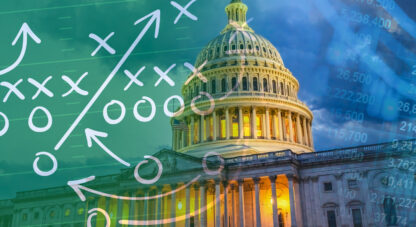Policy Error – The Risk for 2024
This week’s HAI is going to be short. Sickness has descended upon this author, and its manifestations have been bad enough that I’m reminded just how blessed we all are when we can claim health. Given the circumstances, I’ll just offer a few brief thoughts on the week’s developments.
The big enchilada this week, without question, was the honorable Federal Reserve Chairman Jerome Powell stepping up to the mic and giving us his latest thoughts on the economic status of the nation. No surprise, he’s optimistic. More to the point, however, he’s more cautious than many expected. He pushed back hard against the idea of March rate cuts. To be clear, in HAI‘s view, from a long-term perspective, it really doesn’t matter when exactly the chairman blesses a Fed policy easing cycle. What matters much more is why the Fed will ease, and what cost (compromise) they will be willing to pay in order to ease policy.
While the surface-level mainstream narrative is that the economy is strong, inflation is easing back toward target, and we are now at the start of the next great economic boom-cycle, a closer examination of our reality offers reason for caution.
Case in point, this week, when Fed Chairman Powell attempted to express some caution, and elected to push back against over-eager market expectations for aggressive and imminent Fed rate cuts in 2024, the market didn’t like what he was selling—not one bit. Under healthy economic conditions, Powell’s hawkishness would likely have been seen by markets as positive, indicating that policymakers believe they can both lower inflation and maintain solid economic growth. This week, however, the market didn’t love Powell’s hawkish stance, and the devil was in the details on the negative market reaction to Powell’s hawkish bent.
Importantly, when Powell said March rate cuts were unlikely, the market predictably slashed the odds of a March rate-cut. Of much greater interest, however, was the fact that, rather than eliminate expectations for those cuts or expect them to be delayed, the futures market instead immediately priced in a greater total number of rate cuts later in 2024.
In other words, Powell’s rather explicit pushback on the possibility of March rate cuts didn’t inspire confidence. Instead, it caused the market to increase aggregate bets for even more cuts later in 2024. The market extended the timeline on cuts, but also reflected expectations for the need for even deeper aggregate cuts by year-end 2024. The message was clear: we are dealing with the increased likelihood of a Fed policy error in which delaying cuts will necessitate more and/or larger rate cuts later as an emergency response measure.
To be clear, there’s really no other way to spin this unusual futures market pricing dynamic than to give full credit to the increased perceived risk of a Fed policy error in 2024. Make no mistake, this week’s reinvigorated regional bank crisis—a crisis directly associated with the high interest rate burden crushing commercial real estate concerns—underscores the risk that Fed policy error will ultimately define 2024 in economic textbooks ever after.
The decidedly bearish market reaction to a hawkish pushback on Fed rate cuts in March certainly adds credibility to HAI favorite economist David Rosenberg’s view, articulated this week, that, “The rubber will meet the road in 2024, and the bull market in complacency will unravel as the recession few see, and few are positioned for, finally comes into view.”
Rosenberg continued, “The painful drawdown in 2022 should serve as a reminder for what happens when recession risks get priced into the equity market… Think of what happened in 2022 as an appetizer.” Again, the key question is economic health, and in HAI‘s view, we can’t at all claim it. Whether the Fed doesn’t cut rates and we get recession, or the Fed does cut rates and we reaccelerate inflation, the bottom line is that the sand in the hourglass is running out on Goldilocks conditions. However those conditions break down, market repricing will soon follow. When that time comes, it’s the regime-change assets in the hard asset universe that seem poised, first in line, to benefit from a new era of new pricing.
Weekly performance: The S&P 500 gained 1.38%. Gold jumped 1.80%. Silver was lower by 0.31%. Platinum lost 2.14%, and palladium dropped by 1.29%. The HUI gold miners index was up 0.30%. The IFRA iShares US Infrastructure ETF gained 0.67%. Energy commodities were volatile and lower on the week. WTI crude oil lost 7.35%, while natural gas continued lower, down another 4.31%. The CRB Commodity Index was down 2.13%, and copper shed 0.78%. The Dow Jones US Specialty Real Estate Investment Trust Index was down 0.42%. The Vanguard Utilities ETF was up 0.55%. The dollar index was up 0.53% to close the week at 103.78. The yield on the 10-yr U.S. Treasury was lower by 12 bps to close at 4.03%.
Have a wonderful weekend!
Best Regards,
Morgan Lewis
Investment Strategist & Co-Portfolio Manager
MWM LLC















